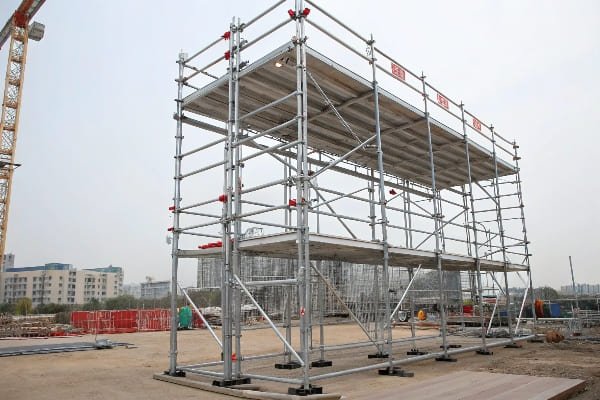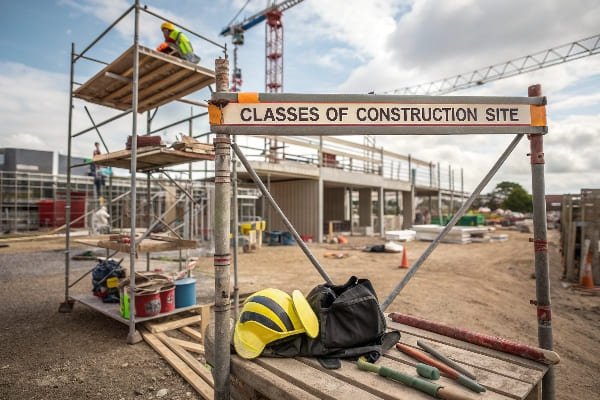For years, I've seen all types of scaffolding on construction sites, from light-duty towers for painters to massive structures for heavy concrete work. Understanding these classifications is critical for safety and efficiency.
A Class 4 scaffold1 refers to a specific load-bearing capacity classification, typically found in European (EN 12811-1) or British (BS 5975) standards, designed to support medium to heavy-duty loads. It signifies that the scaffold platform can safely bear a uniformly distributed load of up to 3.0 kN/m² (approximately 300 kg per square meter), making it suitable for tasks involving a significant amount of materials, tools, or multiple workers.

When designing and supplying scaffolding, like we do at TSX Scaffolding, matching the scaffold class to the job's demands is non-negotiable. Using a scaffold that's too light for the load can lead to catastrophic failure. Let's dive deeper into what Class 4 means and how it compares to other common scaffold classifications2.
Why Are Scaffold Load Classes Important?
Years ago, I witnessed a scaffolding platform buckle because it was used for a task far heavier than it was designed for. It was a clear demonstration of why load classes aren't just technical jargon; they're about preventing serious accidents.
Scaffold load classes are crucial because they dictate the maximum weight a scaffold platform can safely support, preventing structural failure, collapse, and ensuring worker safety. These classifications, typically defined by national or international standards, guide users in selecting the appropriate scaffold for the specific tools, materials, and personnel required for a construction task.

Understanding the Role of Load Classes in Safety
Every piece of scaffolding, every component, and the entire assembled structure has limits. Exceeding these limits can have severe consequences, not just for the equipment but for human lives.
| Factor | Impact of Understanding Load Classes | Risk of Ignoring Load Classes |
|---|---|---|
| Structural Integrity | Ensures the scaffold frame and platforms are robust enough to handle the combined weight of workers, tools, and materials without deflection or collapse. | Leads to overloading, causing components to bend, break, or the entire scaffold to fail, resulting in sudden collapse. |
| Worker Safety | Prevents falls, crushing injuries, or being hit by falling objects due to a compromised platform. Workers can operate confidently on a stable surface. | High risk of workers falling from height, being trapped in a collapse, or injured by material falling from unstable platforms. |
| Material Management | Guides proper distribution of materials on the platform, preventing concentrated loads that could cause localized failure even if the total load is within limits. | Leads to uneven loading, creating stress points that can cause localized platform failure even if the overall scaffold class seems appropriate. |
| Legal Compliance | Adherence to recognized safety standards and regulations, avoiding fines, project delays, and potential legal liabilities in case of an accident. | Non-compliance can result in severe penalties, stop-work orders, criminal charges, and civil lawsuits, significantly impacting a company's reputation and finances. |
| Project Efficiency | Reduces downtime due to accidents or equipment failure, ensures work can proceed safely and smoothly, and minimizes repair costs for damaged scaffolding. | Frequent halts due to safety concerns, damaged equipment requiring replacement, and significant delays to project timelines due to accidents or inspections. |
I always emphasize with my clients that underestimating workload requirements and misclassifying a scaffold is an invitation for disaster. It's not just about the weight of a few people; it's about the tools, the bags of mortar, the stacks of bricks, the concrete pouring equipment – all of it adds up. For instance, if you're doing heavy masonry work with natural stone, you’ll need a much higher class than if you're just painting. These classes provide a universal language for safety engineers and site managers to communicate the structural demands required for any given job.
How Does Class 4 Compare to Other Scaffolding Classes?
When I'm discussing a project with a contractor, the first thing I ask is: "What class of scaffold do you need?" This immediately tells me what kind of load capacity we're talking about, and how robust the system needs to be.
Scaffolding classes define permissible load limits per square meter of platform area, ranging from Class 1 (light-duty) to Class 6 (heavy-duty). Class 4, with its 3.0 kN/m² capacity, sits in the upper-middle range, making it suitable for tasks like general bricklaying, concrete work, and handling moderate material stacks, bridging the gap between light repair work and specialized heavy construction.
A Breakdown of Common Scaffolding Load Classes
Understanding the spectrum of classes helps in precise selection, ensuring optimal safety and cost-effectiveness. In Europe, these classes are primarily defined by the EN 12811-13 standard.
| Class (EN 12811-1) | Uniformly Distributed Load (UDL) (kN/m²) | Equivalent UDL (kg/m²) (approx.) | Typical Applications |
|---|---|---|---|
| Class 1 | 0.75 kN/m² | 75 kg/m² | Inspection, light cleaning, facade work with only hand tools and personnel. |
| Class 2 | 1.50 kN/m² | 150 kg/m² | Painting, plastering, rendering, light repairs with minimal materials. |
| Class 3 | 2.00 kN/m² | 200 kg/m² | Light blocklaying, general construction work with limited material storage. |
| Class 4 | 3.00 kN/m² | 300 kg/m² | Bricklaying, concrete work, general construction, moderate material storage. |
| Class 5 | 4.50 kN/m² | 450 kg/m² | Heavy masonry, material storage areas (e.g., pallets of bricks), heavy repair. |
| Class 6 | 6.00 kN/m² | 600 kg/m² | Very heavy masonry, structural steel erection, large material storage, heavy equipment. |
When I was involved in a large multi-story residential project, Class 4 scaffolding was our go-to for the outer facade where bricklaying was performed. Workers needed space for themselves, their mortar boards, stacks of bricks, and tools. A Class 3 scaffold would have been overloaded quickly, risking collapse. For areas involving pouring concrete, especially with buckers of wet concrete, or handling structural steel members, we would typically specify Class 5 or Class 6. This classification system gives us a clear metric for structural design, ensuring that the scaffold components – like ledgers, transoms, and standards – are adequately sized and the overall structure has sufficient bracing to support the required loads safely. It's not just about the main platform's capacity, but the entire system's ability to transfer those loads to the ground securely.
What Are the Design and Safety Requirements for a Class 4 Scaffold?
Designing a Class 4 scaffold isn't just about putting poles together; it's an engineering challenge. When I review a scaffold design, especially for a Class 4 requirement, I'm looking for meticulous adherence to standards.
A Class 4 scaffold must be designed and erected in strict compliance with relevant national and international standards (like EN 12811-1), ensuring all components (standards, ledgers, transoms, bracing, and platforms) are structurally sound enough to withstand the specified 3.0 kN/m² uniformly distributed load plus dynamic forces. Key requirements include adequate base plates, proper bracing, robust connections, and a comprehensive inspection and maintenance regime.
Key Components and Safety Protocols
As a designer for TSX Scaffolding, my focus is always on ensuring our products meet and exceed these demanding safety specifications.
| Component/Aspect | Specific Requirement for Class 4 Scaffold | Why It's Critical for Class 4 |
|---|---|---|
| Standards (Verticals) | Must be adequately sized (e.g., 48.3 mm diameter, minimum 3.2 mm wall thickness steel tubes) and spaced to carry the heavy vertical loads from multiple levels. | They bear the cumulative weight of the platform, materials, and workers throughout the scaffold's height; undersized standards can buckle. |
| Ledgers/Transoms (Horizontals) | Designed to support the working platforms and transfer loads to the standards without excessive deflection. Often require closer spacing for Class 4. | Directly support the heavy load on the platform. Insufficient strength here leads to platform collapse or excessive bowing. |
| Bracing (Diagonal) | Essential for resisting lateral forces (wind) and providing longitudinal and transverse stability, particularly critical for transferring heavy loads. | Prevents racking and swaying under load, especially when handling moving materials or sudden weight shifts. |
| Base Plates & Grounding | Large surface area base plates or sole boards distributed on firm, level ground to prevent settlement or overturning under heavy loads. | Distributes the heavy concentrated loads from the standards over a wider area, preventing the scaffold from sinking or toppling. |
| Connections (Couplers/Systems) | All connections must be robust and certified for the expected loads. For system scaffolding (e.g., Ringlock from TSX), connections provide inherent rigidity. | Weak or improperly secured connections are a common point of failure for heavily loaded scaffolds. |
| Guardrails & Toeboards | Must be installed on all working platforms, capable of withstanding significant impact, preventing falls and objects from falling off. | Non-negotiable safety feature, crucial for protecting workers from falls from height given the higher activity on Class 4 platforms. |
| Inspection & Maintenance | Daily inspections by competent persons, regular formal inspections (e.g., weekly), immediate flagging and repair of any damage or instability. | Continuous monitoring ensures the scaffold remains safe throughout its use, preventing fatigue or damage from compromising its integrity. |
For a recent high-rise project where we supplied Class 4 Ringlock scaffolding, we needed to ensure every connection was secure and every lift was properly braced. We also worked with the contractors to implement a strict load management plan4, including clear signage on platforms indicating maximum permissible loads. It’s also important to consider dynamic loads like wind or impact from materials being hoisted. A Class 4 scaffold must not only support static loads but also withstand typical operational stresses. This comprehensive approach, from design to daily use, is what makes a Class 4 scaffold truly safe for its intended heavy-duty work.
Conclusion
A Class 4 scaffold is a robust solution for medium-to-heavy work, capable of supporting 300 kg/m². Understanding this classification is crucial for safety, ensuring the right scaffold is used for the right job, and preventing potentially disastrous failures.
Explore this link to understand the specifications and applications of Class 4 scaffolds in construction. ↩
Explore various scaffold classifications to choose the right type for your construction needs. ↩
Discover the EN 12811-1 standard for scaffolding to ensure your projects meet safety regulations. ↩
Understand the importance of a load management plan in maintaining scaffold safety. ↩


